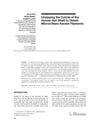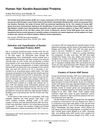TLDR Two Hispanic women developed Plica neuropathica, a condition causing tangled hair, possibly due to hair damage and various risk factors.
The document describes two cases of Plica neuropathica (PN), a rare condition resulting in tangled hair masses, in a 50-year-old woman with a history of contact dermatitis and a 46-year-old woman who used various hair products. PN is characterized by a hard keratin cement binding the hair, leading to a matted and dirty appearance, and is associated with non-scarring alopecia. The condition's pathogenesis is unclear but may involve physical and chemical damage to the hair shaft, with risk factors including self-neglect, hair felting, substance use, religious practices, chemotherapy, immunosuppressive drugs, infections, and contact dermatitis. Diagnosis can be aided by trichoscopy, which reveals specific hair shaft abnormalities. Treatment typically requires cutting the affected hair, with manual separation possibly helping in early stages.
2 citations
,
May 2022 in “International journal of trichology” Plica neuropathica is a tangled hair condition that may be caused by hair damage or psychiatric issues and is treated by cutting the hair and addressing mental health.
2 citations
,
January 2018 in “Indian dermatology online journal” A homeopathic antidandruff shampoo caused severe hair matting in a girl.
 14 citations
,
August 2006 in “Clinical and Experimental Dermatology”
14 citations
,
August 2006 in “Clinical and Experimental Dermatology” A girl with no hair neglect developed plica neuropathica in the hospital, lost all her hair, but it grew back.
22 citations
,
January 2020 in “PeerJ” Keratin peptides in hair might help identify gender and ethnicity.
55 citations
,
January 2013 in “International Journal of Cosmetic Science” African hair's keratin structure is influenced by its higher lipid content.
122 citations
,
October 2010 in “Clinica Chimica Acta” Washing hair with water or shampoo lowers cortisol levels in hair.
 7 citations
,
August 2006 in “Biopolymers”
7 citations
,
August 2006 in “Biopolymers” Researchers extracted tiny keratin filaments from human hair by unzipping its outer layer.
 71 citations
,
August 2005 in “The journal of investigative dermatology. Symposium proceedings/The Journal of investigative dermatology symposium proceedings”
71 citations
,
August 2005 in “The journal of investigative dermatology. Symposium proceedings/The Journal of investigative dermatology symposium proceedings” Hair keratin-associated proteins are essential for strong hair, with over 80 genes showing specific patterns and variations among people.



